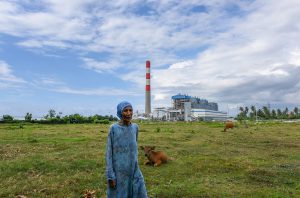Bali has become a popular destination for Chinese tourists in recent years, but the Indonesian government’s drive to keep growing the sector is threatening the island’s water resources.
Chinese tourist arrivals to Indonesia increased by 51% year-on-year in 2014, by double digits for the next two years, and then by a record 57% in 2017.
The government aimed to attract 20 million tourists to the country in 2019, with 10 million coming from China. In fact, the number of Chinese tourists actually declined in 2019 to about 2.1 million, according to Statistics Indonesia.
In December, The Australian reported that the Balinese tourism industry was facing significant headwinds for the first time in more than a decade. This reflects specific problems faced by the sector and by Chinese tourism in particular.
Chinese tour operators were coming under increased scrutiny due to widespread “zero-dollar” tours: cheap package tours sold in China that directed customers to Chinese-owned shops and restaurants in Bali, where they were sold goods at inflated prices, often with no benefit for the local economy.
The coronavirus outbreak in China could further weaken the island’s tourism sector. About 15,000 Chinese tourists have cancelled their flights, many tour operators have closed their services and the Indonesian government has temporarily stopped flights to and from mainland China.
Weaker economic conditions in China together with tourism overcrowding and environmental degradation in Bali, Indonesia’s main tourist draw, are also possible causes for the decline in numbers. A slower-burning issue is water.
Bali’s water worries
Water insecurity is a growing challenge on Bali, with at least one media outlet reporting that the island is at risk of “running out”. As Bali receives an average of over 1,200 millimetres of rainfall a year, it is unlikely to actually run out of water. But the pressure on water is real and its main cause is tourists using more than they need to. This is likely to be difficult, but not impossible, to overcome.
The Indonesian Environmental Protection Agency found that 260 of Bali’s 400 rivers had run dry. Groundwater reserves, which are at record low levels of less than 20% of their usual capacity, will take years to recover. According to one analysis, the water table has dropped by more than 50 metres over the last ten years in some areas of the island, with the densely populated south particularly affected. Seawater is increasingly infiltrating aquifers, polluting those water sources and undermining agricultural production.
Rice farming is still a major component of the Balinese economy and culture. It faces challenges from declining productivity, increased operating costs, water shortages and soil degradation. The island’s rice terraces are also major tourist attractions in their own right.
The tourism industry is the main consumer of water, accounting for about 65%. It is also the main economic sector on the island – 80% of its gross domestic product is derived from the industry. The average tourist, however, is believed to use three times more water than the average Balinese person.
Technical fixes
Desalination is often touted for relieving water-stress on small islands. The Maldives and the Seychelles, which also have tourism-based economies, obtain most of their water from desalination plants. The Seychellois public water supply is supplemented with desalinated water during the dry season while the Maldives has constructed desalination plants in locations with insufficient or low-quality water. Some of those plants have operated since the late 1970s. Treated wastewater is used to a lesser extent on some resort islands and usually only for the irrigation of food crops and landscaping.
Desalination uses large amounts of energy and is environmentally problematic. Energy accounts for about half of the total operation and maintenance costs of a typical desalination plant. The average large-scale reverse-osmosis plant consumes between three and five kilowatt hours of electricity for each kilolitre of freshwater it produces. For every litre of freshwater that is produced, however, desalination plants create 1.5 litres of hypersaline brine. The brine can also contain heavy metals and chemicals used to treat the feedwater and prevent contaminants from fouling the desalination membranes. Disposing of this waste is challenging, and in coastal regions it is usually pumped into the ocean.
Modern reverse-osmosis plants require less energy and create less brine than older models, many of which use less efficient thermal processes. Some plants are beginning to use diffusers that increase the volume of seawater mixing with the brine to prevent spots of high salt concentration. Brine also contains valuable minerals, chemicals and salts, such as copper, chlorine, uranium and lithium, which could be extracted from the waste stream. Currently, those extractive options are too costly to be viable, but if environmental concerns surrounding desalination increase, they might become increasingly feasible.
Using desalination to increase the water supply is likely to reduce the immediate pressure on Balinese water resources, but it could also contribute to higher water use as supply constraints are lifted. Uncertainty about the energy intensiveness and environmental trade-offs that could accompany any desalination plants also mean that it is not necessarily the best option.
If Indonesia is serious about massively expanding Chinese tourism to Bali, other measures, such as water conservation and adopting wastewater recycling, could provide more appropriate long-term water security solutions.






![The women of Rahul Nagar live in concern of the impact of the river eating up the lands [image by: Manoj Singh]](https://dialogue.earth/content/uploads/2020/02/नदी-की-कटान-से-प्रभावित-राहुल-नगर-की-महिलाएं-300x225.jpg)

